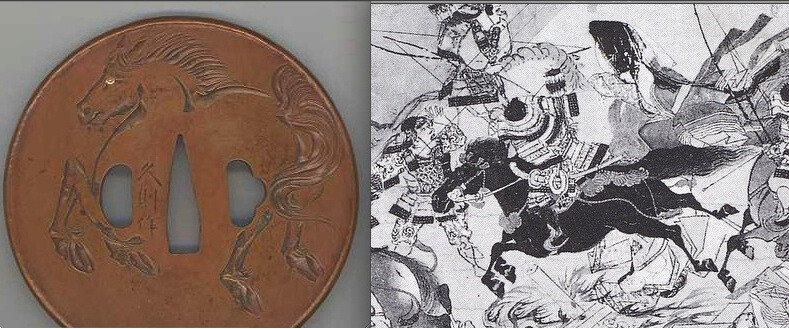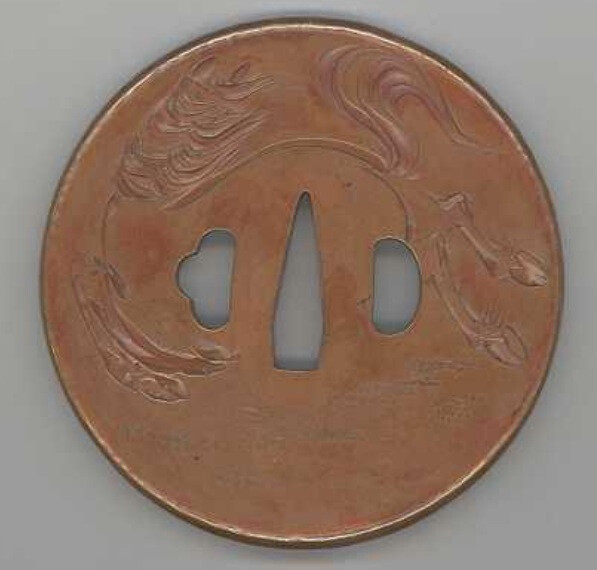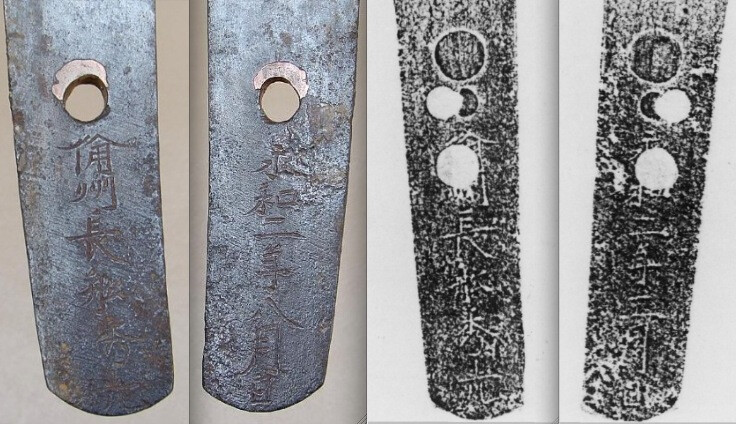-
Posts
786 -
Joined
-
Days Won
1
Content Type
Profiles
Forums
Events
Store
Downloads
Gallery
Everything posted by reinhard
-
Ford, Actually there are remarkable differences and they are making the difference between Japanese aesthetics and Western-orientated design. Hardly any artist working for export during second half of 19th century was able to bridge these poles succesfully without betraying one principle or the other. If you don't mind I would like to stick to Tsuba and their very particular demands. Widening the topic to (Western) images and (Japanese) picture scrolls won't get us anywhere. Show me any (confirmed) tsuba by untraceable (sic!) Hisanori or any other Tsubako with a similar design and workmanship predateing late Bakumatsu or Meiji-period and I will bow. This tsuba fits all criteria of late work made for export. Size, design, execution, a dubious, untraceable mei etc. It's quite obvious, don't you think? regards reinhard
-
Well, I do. Even more so when looking at the reverse. Design looks rather "modern" and there is hardly anything I can connote with works predating Bakumatsu or Meiji-period. The size of the plate is somewhat oversized which is a typical feature of Hama-Mono. This is not necessarily a bad thing, for some tsuba made for export were crafted by highly skillful artists. Lacking raw materials or the like, Japan depended mainly on traditional craftsmanship when it was entering global markets during later 19th century. When the days of the samurai ended, some of the artists and craftsmen found a new market, but the new customers were different. Instead of samurai and local merchants, Westerners had to buy their products. Guess what happened. This particular tsuba fits in there perfectly to me. Skillfully executed it is, but quite far from any traditional sense of aesthetics. reinhard
-

Stepping away from Moderation
reinhard replied to Ted Tenold's topic in General Nihonto Related Discussion
Fare thee well, Ted. It was a pleasure to meet you at Token Ichi two years ago and I hope we will meet again on the road. Thanks. reinhard -
I agree with Ted. Western expectations (size, design, proportions, colour etc.) combined with traditional Japanese skills and craftsmanship automatically lead to Hama-Mono: things made for export during Meiji-period. Everything about this tsuba is pointing this way. It looks like a well executed piece of work, but somehow far from Japanese sense of aesthetics. Just one question: What are the measurements of this tsuba (horizontal and vertical diameter)? reinhard
-
Forget about Taikans and hi-res pics. No serious collector will buy a KIYOMARO blade before seing it in his own hands. I've seen about a dozen of his best blades in hand, including the one he made for Kubota Sugane, presently Juyo Bijutsuhin. You are losing yourselves in virtual, meaningless discussions. reinhard
-
Hi George, Basically I agree with your statement, but since NMB and sword trade are almost impossible to separate, I'm trying to differ between professional dealers guided by commercial interests only and amateurs. I'm not willing to do homework for the former but am ready to help the latter. The amateur can be an enthusiastic beginner as well as an overcharged heir knowing nothing about NihonTo at all. He has a right of getting a reasonable answer as well. I will not provide him with answers unasked, but I don't care either if my post on NMB gets to him by other ways. Personally I'm favouring more transparency of personalities and their intentions on NMB and a separation of interests here, but this is not my cup of tea. Brian and his team have to decide. Since informations gained from NMB are dispersing into business through all sorts of channels, inside and outside of NMB have become very difficult to discern. In the end it seems only natural to me that everybody is trying to get advantage from this board. Why protect some ("quiet, knowledgeable bidder") and leave the others? regards reinhard
-
What exactly do you think is NMB made for? reinhard
-
Bunnies in a whirl-pool under the moon of love. Check short treatises by famous philosopher Mr.Hugh Hefner. reinhard
-
The "SA" mei on this blade cannot be one of famous O-SA. Its writing style is completely different from SA's and placed on the sashi-omote side of a katana is excluding it from any further speculations. However, there was a sword-making centre in Chikugo province during Muromachi period, where Kaji used this famous name as a trademark. He was supposed to be their predecessor. A similar phenomenon can be seen on swords made in Seki during Muromachi period BTW. Kaji there used the trademark "KANEUJI" for a quite a while. Therefore this mei is not necessarily a gimei. Further research will be necessary. reinhard
-
My previous post was meant to be ironical. It failed. But seriously though. A blade with little nioi-giri actually can pass shinsa. There is a well-known katana by shodai MURAMASA with obvious nioi-giri f.e.. A Japanese friend of mine told me that this "flaw" might be considered a feature of this particular style, for the earlest MURAMASA blades tend to have an extremely thin and constricted nioi-guchi in places. However, nioi-giri is a flaw that should be avoided, but if the blade is very good otherwise, it will be tolerated. Cosmetic repair of lost nioi-guchi exists. Adding a row of very small, super fine scratches, parallel to each other, perpendicular to the Ha and placed along the missing nioi-guchi line, will create a stunning effect when the blade is held pointing towards light. I've seen a missing boshi replaced that way and the fraud was pretty hard to detect. A shinsa-team, however, will not be fooled by cosmetics like these. reinhard
-
That's it! Find a polisher to correct substantial faults, but don't forget to ask him for how long the make-up will last. Interesting first-draft that is. It shouldn't be your last though. reinhard
-

NAOTANE AND HIS MEI AND KAO
reinhard replied to Eric H's topic in General Nihonto Related Discussion
Hello Eric, Thank you very much for this most entertaining and educative riddle. I have a question though. According to Tanobe-sensei the signatures D left and both from table E are displaying one or several features of Kajihei's false mei of NAOTANE (his teacher). Are these blades safely attributed to NAOTANE? best regards reinhard -
Steve, I'm sorry for the lack of clarity in my post. What I meant was: Reasoning and argumentation need a foundation. There must be impartial parameters to start with. Most of these parameters have been established a long time ago as far as the "classic" Japanese arts are concerned. Asking for individual choice to build reasoning upon is what I meant by "cry for democracy". I have to admit the term was not well chosen, but reasoning without or beyond established parameters is redundant, no matter how strong the chain of logic may be. Unlike modern art, the arts of the sword leave us with hardly any room for setting our own parameters. What I understood from your posts so far is a strong desire to establish your opinion/personal preference by "strength of reasoning", but I wonder what the underlying parameters are? You consider "third-class Momoyama iron" (whatever that means) superior to "the vast majority of Edo Kinko" (also a quite murky expression, don't you think?). It's hard to believe, you are considering these matters so simple. Is it just sublime art from vital Momoyama period vs plain craftsmanship from degenerate Edo period? And what is your judgement based on? Over-simplification makes it hard to discuss. I'm well aware of the fact, that many, if not most Japanese people have little or no affinity to, nor knowledge of their cultural heritage. Therefore I'm not talking of any mysterious, innate ability, given to Japanese people to understand the arts of the sword, but of those Japanese, who are interested in the matter and were encouraged to go this way from early age on (like a good friend of mine, who grew up as son of a well-known collector and sword-dealer). They have a great advantage compared to Westerners, who are discovering NihonTo at a comparatively late moment in their life, handicaped by their "cultural imprint" too. Once in a while I notice for myself that I have to get rid again of some "Western attitudes" towards Japanese arts. It's always a small step forward, although there are gaps I will probably never be able to fill. I understand you are getting tired of this thread. I hope you don't mind. best regards reinhard
-
Relax John, I'm talking about the perception of art and craftsmanship, not politics. reinhard
-
You are calling for objectivity that cannot exist according to your previous posts. Theoretically non-Japanese persons can adapt to Japanese criteria of quality, but they have a long way to go. Almost all of them trying never reach true mastery. Their Western point of view is obsolete anyway. Crying for democracy is premature and ignorant in front of an old and most sophisticated culture. reinhard
-
-
I don't like the package. The saya-gaki looks doubtful and the habaki is not worth of a HIDEMITSU blade. There are minor irritations as far as the horimono are concerned. Jacques pointed them out already, but they don't really matter, for they could be due to careless treatment in the past. Anyway, this blade should be put to the test. It has a good chance to be worthwhile. reinhard
-
Are you interested in cormorant fishing? reinhard
-
Some features look doubtful, but the mei is good enough to have it checked by an expert. Therefore the blade should be treated with utmost care from now on. If it turns out to be genuine work, it will be quite a precious discovery. For those who like to investigate any further, here's an example of HIDEMITSU's mei on another tanto dating from the same year: reinhard
-
John, I think you've got the wrong kanji for MASA here. It is probably this one: reinhard aka Bad Santa
-
It's the same thing with EEGs. Great wavy patterns are indicating potential weakness and trouble of the worst kind. It's best to concentrate on flatliners.* reinhard *with kind permission by Wysocki medical school. BTW next semester they are offering great courses in basket weaving and advanced shoe-tying.
-
Well, some of us do. Your feelings of loyalty to Stephen are probably most appreciated by some of NMB's members, but they are not a benchmark in this particular case. As you just said, you don't know what this is all about. reinhard
-
Going along this sad and pathetic thread I stumbled over this statement. Can you specify? reinhard
-
Nevermind. Maybe some day you will. Until then you better forget about your funny theories about German and Anglo-Saxon "races". They won't get you anywhere. I'm neither German nor Anglo-Saxon BTW. reinhard
-
"Good deal....a bargain" "Congrats....what is it exactly?" "deals still can be found on Ebay.....maybe a boy's sword or a smith's sales example....you're doing good...." It is no bargain at all. It needed to be polished properly before telling, but this would cost you many times the amount you have already paid, plus the costs for a decent habaki. Whitish, blurred surface and dark ha are pointing towards an amateurish attempt of "polishing" on some kind of whetstones. Telling by the pictures the blade looks like the top part of a naginata to me. It is definitely not a "boy's sword" or even a "smith's sales sample". These are terms often used helping to sell unidentifiable crap BTW. You "couldn't resist". Remembering my own past I can understand you to some extent. What I do not understand, or let's say, I have an idea, but will not tell right away, is why some of NMB's more "experienced" members are easily giving away the rest of their and this board's credibility and are jumping happily into the swamp of online trade and vague guesses again, even encouraging other people to do so as well. Since some knowledgeable people are still trying to give reasonable advice here (Koichi, Ted, Ford to name a few) their reputation should not not be misused in order to make this board a trap door to the rotten sinks of E and other bays and all the crocs...sorry I meant crooks, hiding there. reinhard






